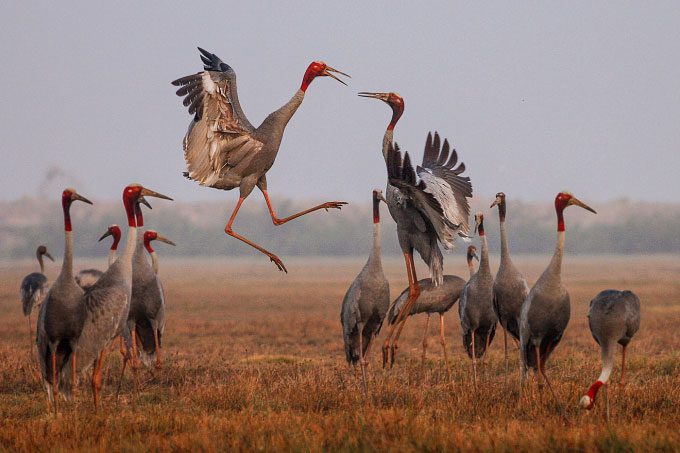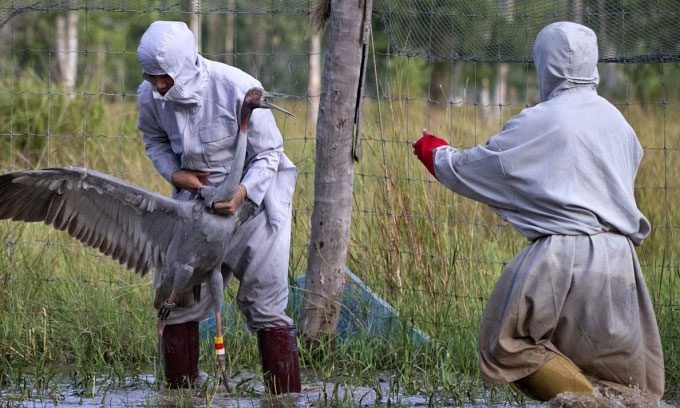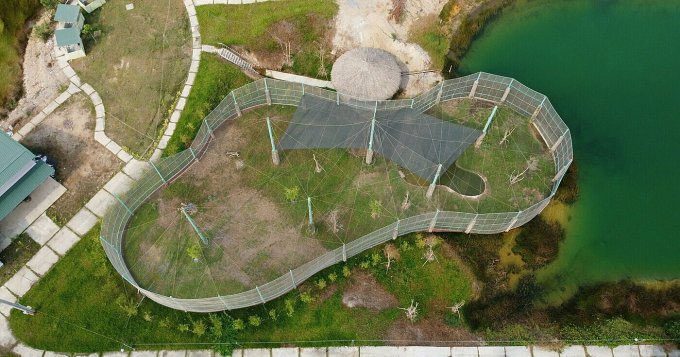The conservation period of 10 years, meticulous care, breeding efforts, and the restoration of a vast ecological area are the reasons behind the total investment of over 185 billion VND for the development of the crane population.
Recently, Đồng Tháp approved a conservation project for the crane population transferred from Thailand, to be implemented at Tràm Chim National Park. The total cost includes approximately 56 billion VND for receiving, caring for, breeding, and re-releasing the cranes; 24 billion VND for ecological restoration; 35 billion VND for establishing ecological agricultural zones; and 51 billion VND for infrastructure investment…
According to the plan, over the next 10 years, the province will receive 60 six-month-old cranes from Thailand, agreeing to compensate for costs of 1.2 million USD (nearly 30 billion VND) for Thailand to care for the cranes, train staff, and send experts for inspections and support. The project aims to release 100 cranes into the wild, with a survival rate of 50%. In mid-December, Tràm Chim will welcome the first pair of cranes from Nakhon Ratchasima Zoo.

Red-headed cranes arriving at Tràm Chim in previous years. (Photo: Trần Văn Hùng)
Dr. Trần Triết, Director of the Southeast Asia Crane Conservation Program and project advisor, stated that Thailand will transfer six cranes each year to Vietnam when they are six months old. Upon arrival at Tràm Chim, they will be cared for for 4-6 months to acclimate to the new environment before being released into the wild.
“The process of raising and training is very meticulous. Caretakers wear outfits resembling crane mothers, avoiding face contact and sound to prevent the cranes from becoming overly attached and losing their wild instincts,” the doctor explained.
Additionally, the breeding process for cranes is quite complex. Thailand took 20 years to research, experiment, and faced numerous failures. In the last 10 years, they have successfully bred and re-released cranes, with direct costs of about 7 million USD and 3 million USD invested in environmental education centers. Currently, Thailand has a wild crane population of about 150, with 15-20 chicks born each year.

Raising and training cranes in Thailand before releasing them into the wild. (Photo: ICF).
According to experts, the cranes in the transfer program do not possess migratory instincts and will only live around Tràm Chim National Park. This lack of migration aligns with the requirements of international conservation organizations, preventing population decline as they would not fly to uncontrolled environmental areas.
Therefore, a crucial issue, according to Dr. Triết, is that the park must ensure a suitable environment for the cranes to live, not only in the core area of the national park but also in the surrounding rice fields, which should be cultivated in an ecological manner. Farmers are encouraged to minimize the use of fertilizers and pesticides.
“Conserving cranes is not just about the amount of money spent but focusing on the achieved goals, from conserving a critically endangered species, restoring the Tràm Chim ecosystem, and supporting the development of green agriculture in Đồng Tháp province,” Dr. Triết shared.
Mr. Đoàn Văn Nhanh, Deputy Director of the Tràm Chim National Park Conservation and Development Center, noted that the park will soon implement multiple solutions to restore the ecosystem. Areas A1, A4, and A5, where the cranes usually reside, will have their water levels lowered and dense layers of vegetation burned to help the sedge (the main food source for the cranes) thrive.

Cranes’ enclosure at Tràm Chim National Park. (Photo: Trần Thanh)
Tràm Chim spans 7,500 hectares and is recognized as the fourth Ramsar site in Vietnam. It hosts many rare bird species, particularly the red-headed cranes migrating from Cambodia to feed and stay from December to April the following year before leaving. In the 1990s, the park recorded a large influx of cranes, sometimes numbering in the thousands, but their presence has dwindled over the years, with some years seeing no arrivals.
The red-headed crane is notable for its bare red head and neck, patterned wings, and gray tail. Adult cranes stand 1.5-1.8 meters tall, with a wingspan of 2.2-2.5 meters, weighing 8-10 kg. At four years old, they form pairs to breed and spend a year raising their young before producing another brood.
According to the International Crane Foundation, the global population of red-headed cranes is estimated at 15,000-20,000, with 8,000-10,000 residing in India, Nepal, and Pakistan. In the Indochina region (primarily Vietnam and Cambodia), around 850 red-headed cranes were recorded in 2014; however, by 2014, the population had dwindled to 234, and currently, there are approximately 160 remaining.




















































